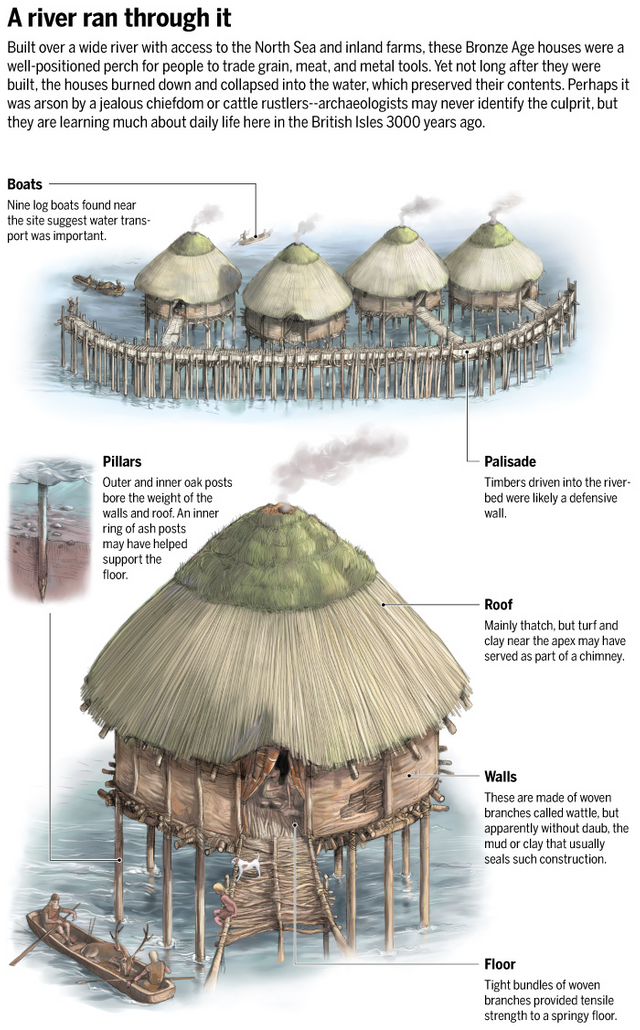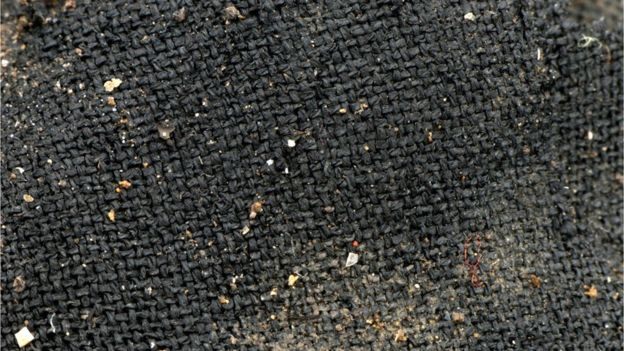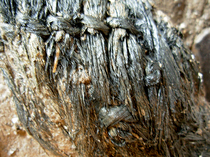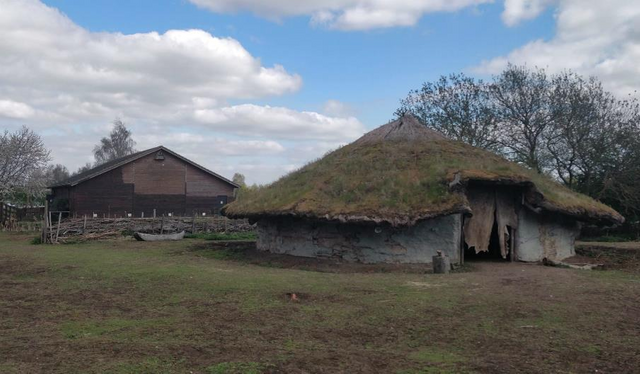Last week, while I was poorly, I was flicking through radio programmes and I came across one about the Fens, a lowland area surrounding The Wash, the largest bay in England.
From there, I learned about Must Farm, a Bronze Age settlement nearly 3,000 years old, built on stilts over a river and destroyed by a catastrophic fire about six months or so after it was built. No human remains have been found, so the homesteaders escaped.

Source Image from an article in Science magazine giving an overview of the finds, including textiles.
As the fire raged, the settlement quickly collapsed into the river below, where it became covered in sediment and was preserved for the next several thousand years. Recent excavations have found one of the biggest and most well-preserved Bronze Age sites in Europe.
Astonishingly, and really rare, the site has preserved fabrics, yarns and threads, and not only finished fabrics as you might find in a burial site or a hoard, there are also yarn and fibre bundles, spindles and beads.

Source This piece of woven fabric is made of bast vegetable fibres, probably linen made from flax. It's a very fine, high-quality piece, evenly woven, with a finely spun and plied yarn with no slubs or unevenness. Some of these fabrics have 30 threads to a centimetre: for comparison, the average linen tea towel has 10 or 11 threads to a centimetre.
Source Dr Susanna Harris talks about the types of textiles and the methods of producing them that in the Bronze Age.
As well as weaving, twining was another way of creating fabric. We would mostly understand twining now as a method for creating mats and screens, but in the Bronze Age it was used to create a flexible textile with drape that may have been used for clothing.

Source Twined weave
Close-up of a textile worked in a basketry-like technique, but made of flexible plant fibres (probably tree bast). This is likely to have been part of a garment such as a cape, much like the one worn by Otzi the Ice Man. The photo shows a single horizontal row of twining, with some knots below, where extra bundles of fibre have been added in.

Source Fine linen with a beaded and knotted border.
Some of the woven linen fabrics are made with threads as thin as the diameter of a coarse human hair. Culture 24.
More information about textiles and the Bronze Age settlement as a whole can be found at each of the sources, with many photographs and diagrams. The community was a materialistic one, with many possessions, including beads and jewellery from Europe and the Middle East; they ate well including deer and boar as well as domesticated animals, and a variety of ancient grains.
There are two series of short videos about the textiles found at Must Farm:
Series 1
Series 2

Source You can also visit reconstructions of Bronze Age homes at Flag Fen, a neighbouring Bronze Age excavation site, about forty miles from Leicester.
Very interesting & cool idea.
However it is a saluatory lesson to the Seasteaders.
Such a settlement is very vulnerable to attack by fire, unlike stone houses with a stone wall on land.
Without naval dominance of the surrounding waterways, any such settlement isn't going to last long.
Downvoting a post can decrease pending rewards and make it less visible. Common reasons:
Submit
Not sure when they got to stone houses. Wattle and daub and thatch continued to be popular right up the the eighteenth and nineteenth centuries.
It may have been marauders, but other evidence from around this time suggests that there were sophisiticated agreements in place about grazing and a a lot of co-operation to manage a difficult but potentially abundant environment. There's a large scale system of fields with drainage and hedging leading to droveways, and estimates of something like a thousand head of sheep being reared in homesteads.
Downvoting a post can decrease pending rewards and make it less visible. Common reasons:
Submit
Pretty fascinating! I found similar ancient fabric examples just yesterday flipping through a book I have of the Danish National Museum's collection of textiles. There were medieval Norse hoods found in Greenland, and like the fabrics you describe above, these were finely woven, much more elaborate than they expected ancient fabrics to be!
Downvoting a post can decrease pending rewards and make it less visible. Common reasons:
Submit
I've got a bit addicted to watching the videos - about all aspects of the dig, not just textiles. 😍
Downvoting a post can decrease pending rewards and make it less visible. Common reasons:
Submit
This was so interesting! The way those houses were built and arranged was ingenious! I loved learning the different techniques and fibers that were used. It’s so amazing to me how things are made from natural resources! Everything was put in it’s place for a reason. I loved the video and how she showed us the hidden fibers inside! Way cool! Thanks for the enlightenment :)
Downvoting a post can decrease pending rewards and make it less visible. Common reasons:
Submit
I agree, it was truly fascinating to learn about. I'm looking forward to a visit to the museum.
I like the tradition - 3,000 years on, we're still creating.
Downvoting a post can decrease pending rewards and make it less visible. Common reasons:
Submit
I love it! History and textiles are both fascinating subjects, and when they are combined we really get a picture of the everyday lives of real people.
Downvoting a post can decrease pending rewards and make it less visible. Common reasons:
Submit
Me, too. I'm looking forward to visiting the museum. It's not far from where I live.
Downvoting a post can decrease pending rewards and make it less visible. Common reasons:
Submit
Very interesting site and it would be amazing to visit the reconstructions. Although I have studied history and archeology I have near to no imagination in regard to the living conditions. For me history is somehow abstract (more documents and theories) like fiction I guess. When I read about such fascinating findings as the good preserved fabric you write about I am instantly interested how to date it, to compare different technologies, if there was exchange of technologies and with whom etc... but I cannot imagine how it must have felt to live in such a village.
Reading about history in context of #needleworkmonday makes it more tangible for me, perhaps I am more open for the process and less for the scientific classification... sorry, I am writing a bit confused....
The other thought that pop up on my mind every time I read about culture techniques of ancient times is, how old some of them are. I am amazed that people could make faience already 15.000 BCE
All in all I am extremely glad not to live in older times. It is fascinating from a distance, but hearing about the hardship... wow.
Downvoting a post can decrease pending rewards and make it less visible. Common reasons:
Submit
I'm very glad I didn't live then, I keep thinking how cold it would have been in the winter! I love finding out about earlier cultures - always much more sophisticated than we imagine. When I see things like burial mounds that would have taken many months to build, I'm amazed at the level of organisation, co-operation and wealth that would have been needed for them to come into being. The Fen people had complex farming and social agreements that allowed them to prosper, 2,000 years before written records arrived here.
Downvoting a post can decrease pending rewards and make it less visible. Common reasons:
Submit
Interesting location!
Downvoting a post can decrease pending rewards and make it less visible. Common reasons:
Submit
Yes, I'm looking forward to seeing the museum.
Downvoting a post can decrease pending rewards and make it less visible. Common reasons:
Submit
Cool that so much fiber was found! Thanks for the links to the videos!
Downvoting a post can decrease pending rewards and make it less visible. Common reasons:
Submit
I hope you enjoy them, if you get a chance to view them :)
Downvoting a post can decrease pending rewards and make it less visible. Common reasons:
Submit
Such a shame such amazing crafted structures were destroyed by a fire , it would be nice to experience such a thing in this day and age would of been interesting if they rebuild their homes but somewhere else in perhaps calmer waters, thanks for the lesson @shanibeer.
Downvoting a post can decrease pending rewards and make it less visible. Common reasons:
Submit
I think they did re-build elsewhere, but they weren't preserved for us :)
I'm going to visit the museum in the next couple of weeks, should be interesting!
Downvoting a post can decrease pending rewards and make it less visible. Common reasons:
Submit
nice to know this @shanibeer on those age yarn making was in with their culture.
Posted using Partiko Android
Downvoting a post can decrease pending rewards and make it less visible. Common reasons:
Submit
Yes, it is fascinating, isn't it? :)
Downvoting a post can decrease pending rewards and make it less visible. Common reasons:
Submit
Hello!
This post has been manually curated, resteemed
and gifted with some virtually delicious cake
from the @helpiecake curation team!
Much love to you from all of us at @helpie!
Keep up the great work!
Manually curated by @vibesforlife.
Downvoting a post can decrease pending rewards and make it less visible. Common reasons:
Submit
Thank you @helpiecake! 😍
Downvoting a post can decrease pending rewards and make it less visible. Common reasons:
Submit
You got a 38.26% upvote from @ocdb courtesy of @shanibeer! :)
@ocdb is a non-profit bidbot for whitelisted Steemians, current max bid is 40 SBD and the equivalent amount in STEEM.
Check our website https://thegoodwhales.io/ for the whitelist, queue and delegation info. Join our Discord channel for more information.
If you like what @ocd does, consider voting for ocd-witness through SteemConnect or on the Steemit Witnesses page. :)
Downvoting a post can decrease pending rewards and make it less visible. Common reasons:
Submit